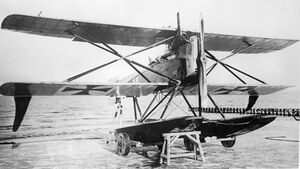Engineering:Hansa-Brandenburg W.11
From HandWiki
| W.11 | |
|---|---|

| |
| Role | Fighter seaplane |
| National origin | Germany |
| Manufacturer | Hansa-Brandenburg |
| First flight | 1917 |
| Status | prototypes only |
| Number built | 3 |
The Hansa-Brandenburg W.11 was a fighter floatplane built in Germany in 1917 as a more powerful version of the KDW. Similar in general configuration to its predecessor, the W.11 shared the same unusual interplane strut arrangement, and featured fins above and below the fuselage. Only three examples were built.
Specifications
General characteristics
- Crew: One pilot
- Length: 8.10 m (26 ft 7 in)
- Wingspan: 10.10 m (33 ft 2 in)
- Height: 3.32 m (10 ft 11 in)
- Wing area: 31.4 m2 (338 sq ft)
- Empty weight: 935 kg (2,060 lb)
- Gross weight: 1,233 kg (2,718 lb)
- Powerplant: 1 × Benz Bz.IVa , 160 kW (220 hp)
Performance
- Maximum speed: 176 km/h (110 mph, 96 kn)
- Range: 350 km (217 mi, 189 nmi)
Armament
- 2 × fixed, forward-firing 7.92 mm (.312 in) MG 08 machine guns
References
- Herris, Jack (2012). German Seaplane Fighters of WWI: A Centennial Perspective on Great War Seaplanes. Great War Aviation Centennial Series. 2. Charleston (S.C.): Aeronaut Books. ISBN 978-1-935881-09-4.
- Owers, Colin A. (2015). Hansa-Brandenburg Aircraft of WWI: Volume 2–Biplane Seaplanes. Great War Aviation Centennial Series. 18. n.p.: Aeronaut Books. ISBN 978-1-935881-32-2.
 |

